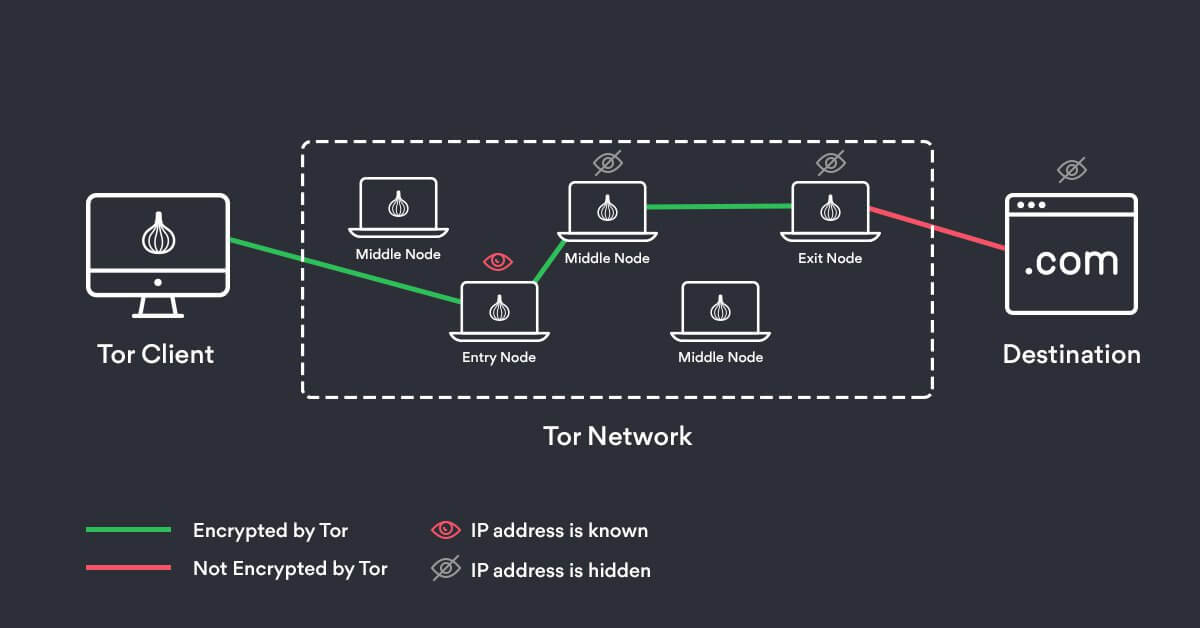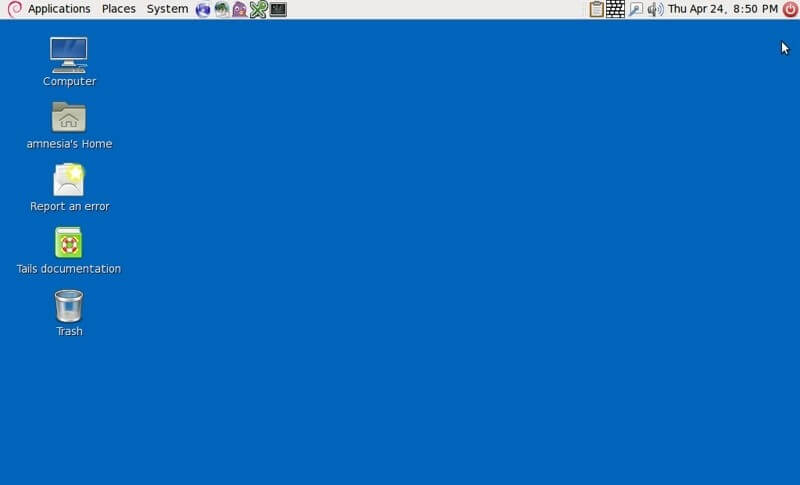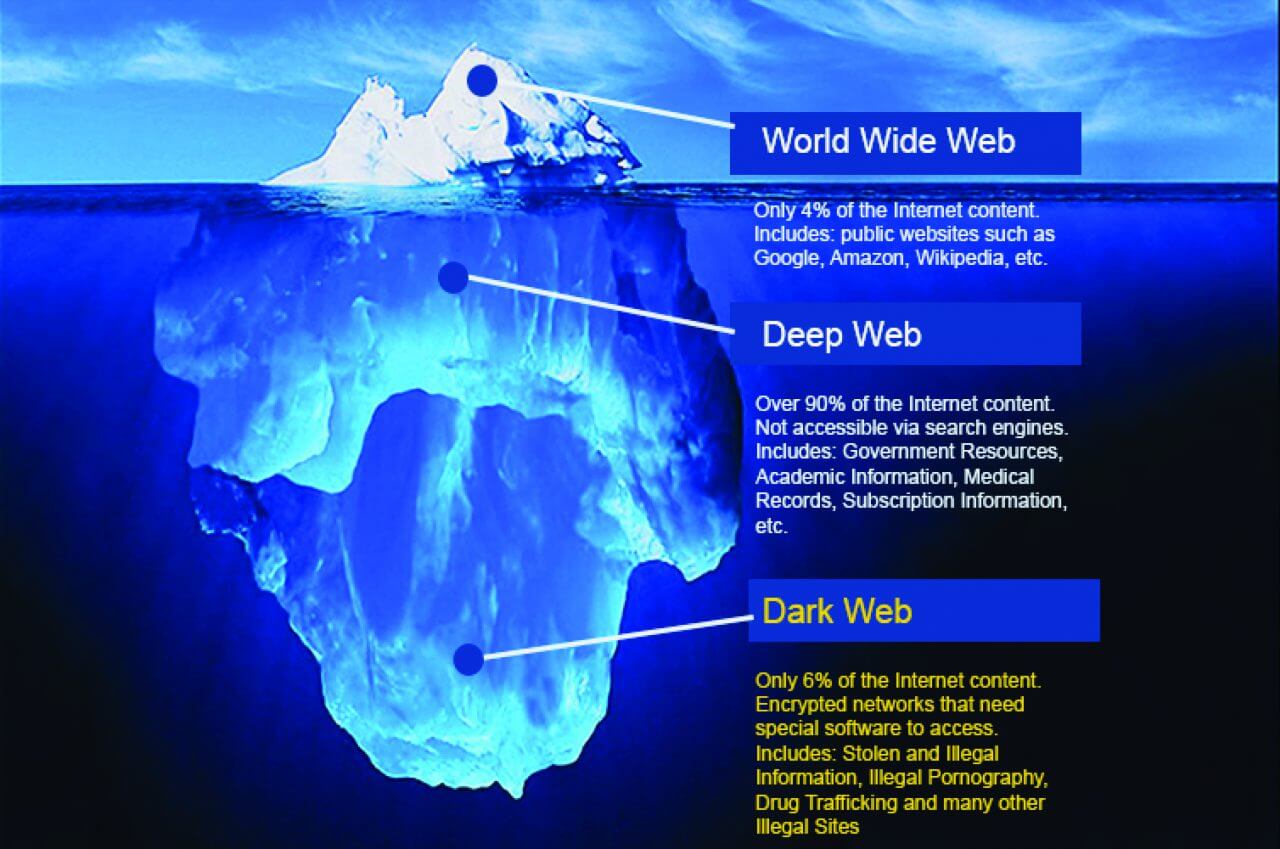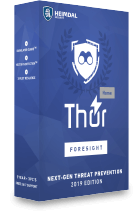How to Get on the Dark Web: A
Step-by-Step Guide
How to safely navigate the dark web
LAST UPDATED ON AUGUST 8, 2019
Dark web, deep web, clear web – just words or more? Well,
in seeing just how many of you are interested in hearing all
about the dark wonders of the internet, I’ve decided to make
this small dark web guide. So, if you want to learn all about
Tor Onion, Silk Road, secret, hush-hush Governmental ops,
and how to get on the dark web, of course, you came to the
right place. Welcome to the shadows, my friends! I will be
your guide.
in seeing just how many of you are interested in hearing all
about the dark wonders of the internet, I’ve decided to make
this small dark web guide. So, if you want to learn all about
Tor Onion, Silk Road, secret, hush-hush Governmental ops,
and how to get on the dark web, of course, you came to the
right place. Welcome to the shadows, my friends! I will be
your guide.
WTH is the dark web anyway?
Now, before we dig into it, we’ll need to stage a little show-and-tell
about the differences between the deep web, dark web, and clear net.
I’ll start with the later because writer’s privilege. So, the clear web is the
very first and very visible layer of the Internet. Basically, it’s what we see
when we do a Google or Bing search for things like cat videos or
popular YouTube songs.
about the differences between the deep web, dark web, and clear net.
I’ll start with the later because writer’s privilege. So, the clear web is the
very first and very visible layer of the Internet. Basically, it’s what we see
when we do a Google or Bing search for things like cat videos or
popular YouTube songs.
From a technical standpoint, clear web defines the content that it’s indexed,
crawled, and displayed by the various search engines. Unfortunately, the clear
web accounts for approximately 4 percent of the Internet. So, if the
clear web isonly a very tiny portion of the Internet, what happened to the
rest?
crawled, and displayed by the various search engines. Unfortunately, the clear
web accounts for approximately 4 percent of the Internet. So, if the
clear web isonly a very tiny portion of the Internet, what happened to the
rest?
Deep web vs. dark web
Welcome to the deep web, the part of the Internet that’s not indexed by
search engines. There’s nothing spooky about the deep web; it contains
like scientific white papers, medical records, tax-related info, PayPal
subscriptions, army communique, and much more. Although the deep
web’s
hiding behindHTTPS forms, its contents can be accessed if you know
what you’re looking for.
search engines. There’s nothing spooky about the deep web; it contains
like scientific white papers, medical records, tax-related info, PayPal
subscriptions, army communique, and much more. Although the deep
web’s
hiding behindHTTPS forms, its contents can be accessed if you know
what you’re looking for.
Most of the websites hosted on the dark web can be accessed on a
credential basis. For instance, if your health provider has a website capable
of displaying bloodwork tests online, that particular section will be hosted
on the deep web – it will not be indexed by Google or Bing and can only
be accessed via password. Oh, nearly forgot to mention that the deep web
accounts for about 90 percent of all Internet.
credential basis. For instance, if your health provider has a website capable
of displaying bloodwork tests online, that particular section will be hosted
on the deep web – it will not be indexed by Google or Bing and can only
be accessed via password. Oh, nearly forgot to mention that the deep web
accounts for about 90 percent of all Internet.
That’s about it about the clear web and the deep web
Remember: Clear, Deep, and Dark.
DRE CELL
Remember: Clear, Deep, and Dark.
DRE CELL
What’s the dark web then? Well, if the clear web is Google’s BFF and
the deep web, its secret lover, then the dark web can only be the evil twin
or the oddball.
the deep web, its secret lover, then the dark web can only be the evil twin
or the oddball.
Accounting for 6 percent of the Internet, the dark web is a most peculiar
blend – on the one hand, it’s a cesspool, a rendezvous place for drug dealers,
black hat hackers, hitmen, and human traffickers. On the other hand, due to
its covert nature (I’ll get to that in a sec), this Internet fold acts like a liaison
between political outcasts and people the free world. It’s also used by people
who want to submit anonymous tips (whistleblowers).
blend – on the one hand, it’s a cesspool, a rendezvous place for drug dealers,
black hat hackers, hitmen, and human traffickers. On the other hand, due to
its covert nature (I’ll get to that in a sec), this Internet fold acts like a liaison
between political outcasts and people the free world. It’s also used by people
who want to submit anonymous tips (whistleblowers).
The dark web is favored by both groups because of its ability to render
anyone and anything invisible. Privacy and anonymity are what you might
consider the core values of the darknet. There’s no such thing as a
mother-server that hosts the entire dark web, but rather a swarm of servers
and nodes that can only be accessed through onion-type links. So, what are
those?
anyone and anything invisible. Privacy and anonymity are what you might
consider the core values of the darknet. There’s no such thing as a
mother-server that hosts the entire dark web, but rather a swarm of servers
and nodes that can only be accessed through onion-type links. So, what are
those?
More on Tor Onions
Since everything’s decentralized on the dark web, there are no crawlers
to bring together the information. Even the URLs, if we can call them that,
are infinitely different from what we’re used to.
to bring together the information. Even the URLs, if we can call them that,
are infinitely different from what we’re used to.
For instance, if you want to access a site like YouTube, all you need to do
is to write the URL in the address bar (i.e. https://youtube.com) or search
for the website using google.com. Now, on the dark web, you’ll have to know
the URL right to the last decimal and character to access it. All dark web
addresses contain seemingly random strings comprised of numbers and
letters,
followed by a .onion extension.
is to write the URL in the address bar (i.e. https://youtube.com) or search
for the website using google.com. Now, on the dark web, you’ll have to know
the URL right to the last decimal and character to access it. All dark web
addresses contain seemingly random strings comprised of numbers and
letters,
followed by a .onion extension.
Again, we shouldn’t lose sight of the fact that the dark web’s the place where
the bulk of criminal activities take place. Everything little sordid detail you
heard over the news about the dark web is painfully true.
the bulk of criminal activities take place. Everything little sordid detail you
heard over the news about the dark web is painfully true.
This is the place where hackers come to purchase data stolen from users or
companies or offer their services in exchange for Bitcoins or other forms of
cryptocurrency. More than that, if you dare to dig deep enough, you can
uncover other hair-raising activities such as human trafficking, child
pornography, torture, or murder on demand.
companies or offer their services in exchange for Bitcoins or other forms of
cryptocurrency. More than that, if you dare to dig deep enough, you can
uncover other hair-raising activities such as human trafficking, child
pornography, torture, or murder on demand.
Charming little spot, isn’t it? Well, that’s where we’re heading. Now,
before you can access the dark web, there a couple of things you must do,
security-wise. Ready? Set? Go!
before you can access the dark web, there a couple of things you must do,
security-wise. Ready? Set? Go!
Preparing to set sail

Source: WikiHow
#1. Install a VPN
VPN services are a must when you’re attempting to access the dark web.
Why?
Because of the long arm of the law, of course. Technically, you are free
to surfon this Internet layer, provided that you don’t engage in any illegal
activities.However, a recent ruling by the US Supreme Court deemed that
even casually browsing the darknet can get you in a lot of hot water.
Why?
Because of the long arm of the law, of course. Technically, you are free
to surfon this Internet layer, provided that you don’t engage in any illegal
activities.However, a recent ruling by the US Supreme Court deemed that
even casually browsing the darknet can get you in a lot of hot water.
This means that if the authorities would intercept your darknet connection
request, they would have had enough reason to search your house and
confiscate the machine used for browsing. So, do yourself a favor and
download a VPN before messing about on the dark web. Need a hand
picking one? Check out this article written by one of my colleagues to
narrow down your search.
request, they would have had enough reason to search your house and
confiscate the machine used for browsing. So, do yourself a favor and
download a VPN before messing about on the dark web. Need a hand
picking one? Check out this article written by one of my colleagues to
narrow down your search.
#2. Install an adequate browser
The first rule of the dark web – never, ever use your default browser to search
for stuff on the darknet. Popular browsers like Chrome, Opera, or Firefox
have tracking technologies that make you very visible on the authorities’
radar. So,if you’re still willing to do this, I would recommend
you download Tor, which is,by far, the safest and easy-to-use onion browser.
for stuff on the darknet. Popular browsers like Chrome, Opera, or Firefox
have tracking technologies that make you very visible on the authorities’
radar. So,if you’re still willing to do this, I would recommend
you download Tor, which is,by far, the safest and easy-to-use onion browser.
Of course, there are others who would argue that Tor being made by the
military for covert communication makes it unreliable, privacy-wise since it’s
believed to be watched. I wouldn’t take that one for granted, but, then again,
there’s no smoke without fire. It’s all up to you.
military for covert communication makes it unreliable, privacy-wise since it’s
believed to be watched. I wouldn’t take that one for granted, but, then again,
there’s no smoke without fire. It’s all up to you.
OF TOR, VPNS AND OTHER DEMONS
Anyway, going back to Tor – why use this particular browser over a regular
one?
Well, that’s a rather long story, but worth telling nonetheless. As you know,
a regular browser mediates between the user’s search request and the site
about to be accessed. Normally, your query will go through the ISP’s DNS,
which in turn consults other resources to help you get the answer you were
looking for.
one?
Well, that’s a rather long story, but worth telling nonetheless. As you know,
a regular browser mediates between the user’s search request and the site
about to be accessed. Normally, your query will go through the ISP’s DNS,
which in turn consults other resources to help you get the answer you were
looking for.
Now, with Tor, the search request kind of bounces around multiple Tor relays
before completing your search request. You’re probably wondering about
what the heck are Tor relays. Well, what we call the clear web is, in fact,
a conglomerate of servers, which are managed either by companies or on
volunteer-basis.
before completing your search request. You’re probably wondering about
what the heck are Tor relays. Well, what we call the clear web is, in fact,
a conglomerate of servers, which are managed either by companies or on
volunteer-basis.
The same principle applies more or less to what we call the dark web. Since
it’s the dark side of the Internet we’re dealing with here, secrecy and
untraceability become inherent. Thus, the info’s stored on Tor relays which
are managed by volunteers.
it’s the dark side of the Internet we’re dealing with here, secrecy and
untraceability become inherent. Thus, the info’s stored on Tor relays which
are managed by volunteers.
So, what happens when you want to access a dark web onion? First of all,
if you followed my advice and installed a VPN, the tunneling signal will be
encrypted. This means that your ISP won’t have a clue about what you’re
about to search for. Sure, it can still see that you want to access a Tor node,
but other than it’s blinder than a mole.
if you followed my advice and installed a VPN, the tunneling signal will be
encrypted. This means that your ISP won’t have a clue about what you’re
about to search for. Sure, it can still see that you want to access a Tor node,
but other than it’s blinder than a mole.
From there, it will be redirected to another node and then another one. Why
does it do that? For anonymity reasons, of course; ‘no breadcrumbs’ means
that there’s no way for someone to trace the signal back to you.
does it do that? For anonymity reasons, of course; ‘no breadcrumbs’ means
that there’s no way for someone to trace the signal back to you.
VPN ONLY? UNLIKELY.
Congrats! You just took the first steps of your dark web journey. Still, there are
a couple of more precautions you must take before you can pop open
Pandora’s box of dark Internet wonders. Getting back to Tor and VPN.
There’s no broad consensus on dark web safety.
a couple of more precautions you must take before you can pop open
Pandora’s box of dark Internet wonders. Getting back to Tor and VPN.
There’s no broad consensus on dark web safety.
However, everyone tends to agree that using only Tor is not enough. The two
of them (Tor and VPN) work in tandem and, as it happens, there are several
ways of tunneling your way all the way through the dark web using this dynamic duo.
Here’s what you need to know.
of them (Tor and VPN) work in tandem and, as it happens, there are several
ways of tunneling your way all the way through the dark web using this dynamic duo.
Here’s what you need to know.
METHOD I – TOR OVER VPN
Sounds very techie, doesn’t it? Well, it’s really not that complicated – using
the Tor over VPN method means connecting to a VPN service before using
the Tor browser. Have to say that this is the most popular and safest method
to access onion links, and, on my part, a marriage made in Heaven: Tor’s an
excellent ‘anonymizer’, while VPN safeguards your privacy.
the Tor over VPN method means connecting to a VPN service before using
the Tor browser. Have to say that this is the most popular and safest method
to access onion links, and, on my part, a marriage made in Heaven: Tor’s an
excellent ‘anonymizer’, while VPN safeguards your privacy.
When using this method, Tor will encrypt your request, which will pass
through your ISP unhindered. From there, it will go through a VPN server
that conceals your IP and wipes geo-locations tags and other elements
your Government or ISP might use to track the request.
through your ISP unhindered. From there, it will go through a VPN server
that conceals your IP and wipes geo-locations tags and other elements
your Government or ISP might use to track the request.
Next step – your request will be transferred to Tor entry nod which in turn
transfers to one or more Tor relays. From there, it gets slingshot to several
Tor exit nodes. Afterwards, your request will be matched with the appropriate
website. Tricky,but effective; that’s why it’s, by far, the best method to access
dark web content.
transfers to one or more Tor relays. From there, it gets slingshot to several
Tor exit nodes. Afterwards, your request will be matched with the appropriate
website. Tricky,but effective; that’s why it’s, by far, the best method to access
dark web content.

Source: NordVPN
PROS OF USING TOR OVER VPN:
- Session logs are not stored (metadata, IP address).
- Traffic’s completely encrypted.
CON(S):
- It doesn’t offer protection against malicious Tor exit nodes.
METHOD II – VPN OVER TOR
Not very safe, but it’s still useable. Recall how Tor oven VPN works? Well,
VPN over Tor is basically its opposite – instead of going through the VPN first,
the signal passes through the Tor network, before going through the VPN.
Why is this method so unpopular? Because it’s not as safe as Tor over VPN.
VPN over Tor is basically its opposite – instead of going through the VPN first,
the signal passes through the Tor network, before going through the VPN.
Why is this method so unpopular? Because it’s not as safe as Tor over VPN.
If the signal goes through the Tor network first, your ISP will be able to see
that you are attempting to connect to a Tor node. Though no one should
bat an eye just because you’re attempting to access the dark web, keep in
mind that in some countries, like the United States, even a simple foray
can get you in trouble.
that you are attempting to connect to a Tor node. Though no one should
bat an eye just because you’re attempting to access the dark web, keep in
mind that in some countries, like the United States, even a simple foray
can get you in trouble.
PRO(S) OF USING VPN OVER TOR:
- Great if you trust your ISP, but not the VPN provider.
- Can bypass blocked Tor nodes.
CON(S):
- ISP can see you trying to access onion content.
- Susceptible to end-to-end timing attacks.
Now, if you want to see what lurks in the dark corners of the Internet but
don’t really trust Tor, there are alternatives. Here is a couple of them:
don’t really trust Tor, there are alternatives. Here is a couple of them:
- I2P – great privacy protection and can access hidden onion links.
- Matrix.org – an open-source project just like Tor. Great for IoT data transfers,
- chats, and WebRTC signaling.
- Orbot – basically a Tor for Android.
- Globus Secure Browser – paid Tor alternative. VPN-powered. It allows the
- users to select preferred geolocation. If you want to take it for a spin, Globus
- features a five-day trial period.
- Comodo Ice Dragon – Firefox offspin. Employs multiple malware safeguards.
- Open-source project.
- FreeNet – open-source project. Sports the Darknet and OpenNet anonymous
- browsing technologies.
#3. Install a VM or disposable OS
I strongly recommend surfing on the dark web using virtual machine software
instead of your locally installed Windows. Why? Because it’s easier to contain
malware in a virtual environment, which can be fully controlled.
instead of your locally installed Windows. Why? Because it’s easier to contain
malware in a virtual environment, which can be fully controlled.
It’s like in those movies where the doctors are experimenting on deadly viral
strains from behind the safety of a glass enclosure. And, as it happens,
there are plenty of VMs to choose from: Oracle VM Virtualbox, VMware
Fusion and Workstations,QEMU, Red Hat Virtualization, Microsoft
Hyper-V, Citrix XenServer, and Xen Project, just to name a few.
strains from behind the safety of a glass enclosure. And, as it happens,
there are plenty of VMs to choose from: Oracle VM Virtualbox, VMware
Fusion and Workstations,QEMU, Red Hat Virtualization, Microsoft
Hyper-V, Citrix XenServer, and Xen Project, just to name a few.
Now, if you really want to take the physical storage devices out of the
equation, you can use what I like to call a disposable operating system – easy
to deploy and to get rid of if you by chance you run into any trouble.
All you’ll need is an 8GB thumb drive, an installationpackage, and a couple of
minutes to get things up and running.
equation, you can use what I like to call a disposable operating system – easy
to deploy and to get rid of if you by chance you run into any trouble.
All you’ll need is an 8GB thumb drive, an installationpackage, and a couple of
minutes to get things up and running.
Let’s dig in.
SLOWLY PLS.....
SLOWLY PLS.....
HOW TO INSTALL TAILS OS

Source: TechSpot
Step 1. Get yourself a thumb drive; 8GB will do, but you can buy one with
morespace if you plan on using it for anything else. Nothing will happen to
the stick(probably).
morespace if you plan on using it for anything else. Nothing will happen to
the stick(probably).
Step 2. Hop on the web and download the installation package for Tails OS.
Step 3. Insert the stick and do a quick format. Be sure to use FAT32 to root
out any compatibility issues. It shouldn’t take longer than a few seconds.
out any compatibility issues. It shouldn’t take longer than a few seconds.
Step 4. Download and install Universal USB Installer or Rufus.
Step 5. Fire up Universal USB or Rufus.
Step 6. Under “Step 1: Select a Linux Distribution from the dropdown to
put on your USB” select Tails.
put on your USB” select Tails.
Step 7. Under “Step 2: Select your ubuntu*desktop*.iso”, click on the browse
button and select the downloaded Tails .img file.
button and select the downloaded Tails .img file.
Step 8. Under “Step 3: Select your USB Flash Drive Letter Only”, use the drop
down box to select your thumb drive’s letter. If it doesn’t show up, check the
“now showing all drives” option.
down box to select your thumb drive’s letter. If it doesn’t show up, check the
“now showing all drives” option.
Step 9. Review the info and hit Create when you’re done.
Note that the process can take anywhere from 5 to 30 minutes depending on
your machine. Sit back, relax, and wait until the installation’s done. When
you’re ready, hit the Close button and you’re all set.
your machine. Sit back, relax, and wait until the installation’s done. When
you’re ready, hit the Close button and you’re all set.
Now what? Well, now it’s time to fire up Tails and do a little bit of tinkering.
HOW TO BOOT FROM USB AND CONFIGURE TAILS
Bogged about your first boot? No worries. It always hurts the first time. Just
follow these steps.
follow these steps.
- Keep the thumb drive in the USB.
- Restart your computer.
- After the splash screen appears, press the appropriate Boot Menu key.
- If you’re tired of randomly pressing keys each time you perform this action,
- check out this article on hotkeys for the boot menu.
- Use your keyboard to select the corresponding drive letter. When you’re done, hit Enter.
- Wait for Tails OS to boot. Since this is the first time, it may take a while. Just
- be patient. Configure Tails and deploy Tor + VPN. Yes, the latest version of
- The Onion Router has an in-built VPN.Get ready to discover the dark and
- sometimes creepy wonders of the dark web.
So how do you get on the dark web?

All done installing and configuring Tor? Great! Fire it up and let’s surf. At first
glance, Tor doesn’t look that different from your regular browser – it has a
search bar, lots of quick-launch icons, the peeled onion icon smack in the
middle of the screen. So, now what? Well, let’s start small.
glance, Tor doesn’t look that different from your regular browser – it has a
search bar, lots of quick-launch icons, the peeled onion icon smack in the
middle of the screen. So, now what? Well, let’s start small.
Although content on the dark web is not as ‘indexed’ compared to the one on
the clear web, you can still use search engines to find stuff. The Hidden Wiki
and Grams are the heavyweights here.
the clear web, you can still use search engines to find stuff. The Hidden Wiki
and Grams are the heavyweights here.
Yay, now I found everything my heart longs for. Not quite: since the dark web
relies on privacy and anonymity, search engines like the Wiki and Grams
frequently return false results. No matter – good or not, the Hidden Wiki is a
great place to start exploring.
relies on privacy and anonymity, search engines like the Wiki and Grams
frequently return false results. No matter – good or not, the Hidden Wiki is a
great place to start exploring.
The Hidden Wiki & Co.
Think of the Hidden Wiki as Wikipedia’s evil twin – looks more or less the
same, but contains links to various dark web categories: editor’s picks,
volunteer, introduction points, financial services, commercial services,
email\messaging, drugs (yes, it’s the real deal), blogs & essays, hosting providers, hacking services, darknet radio (nothing shady about that; just some weird electronic tunes and, occasionally, a bit of jazz), literature (mostly resources on hacking, both ethical and black hat).
same, but contains links to various dark web categories: editor’s picks,
volunteer, introduction points, financial services, commercial services,
email\messaging, drugs (yes, it’s the real deal), blogs & essays, hosting providers, hacking services, darknet radio (nothing shady about that; just some weird electronic tunes and, occasionally, a bit of jazz), literature (mostly resources on hacking, both ethical and black hat).
You can also find quick links here to the stuff that makes the dark web pitch-black dark: contract killers, rape, torture, or murder on demand, child pornography.
Fortunately, in Hidden Wiki, every website is followed by a brief description so that the user knows what to expect (or not). My advice to you would be to stick with the editor’s pick. You can also take a look at the blogs & essays section if you want to find some nifty coding resources.
If you’re feeling chatty, you can always access a chat room. Services like Random Chat connects you with random people using the same service. What happens after that, it’s all to you.
You should stay away from everything labeled “porn”, “card skimming services”, “PayPal hacks”, “firearms”, “real fake IDs and passports”. Believe me – there plenty to go around and each and every one of them are being kept under surveillance, not to mention the fact that you’ll get exposed to some stuff that will definitely make you take several cold showers.
Hidden Wiki’s not the only search engine online. Here are a couple of alternatives in case you get bored with Wiki.
- DuckDuckGo – also available on the clear web. The best thing about DuckDuckGo is that it doesn’t track your searches. One can say that it’s the Google of the dark web.
- Torch – considered the first dark web search engine, Torch boasts a database of several million onions links. Works just like Yelp. It even comes with recommendations, although most of them append websites like the infamous Silk Road.
- WWW Virtual Library – if Torch and Hidden Wiki are old, the triple-W Virtual Library is Cthulhu-old; as in the elder god of search engines. What’s even better is the fact the WWW Virtual Library contains info dating back to the beginning of the Internet: logs, documents, pictures, and everything in between.
Fun fact: The Virtual Library was founded and, for a very long time, curated by none other than Tim Berners-Lee, the George Washington of the Internet. So, if you’re looking for obscure Internet facts, very old documents, Berners-Lee’s brainchild is the way to go.
- Uncensored Hidden Wiki – think regular Hidden Wiki is bad? Wait till you see the uncensored version. As the name suggests, it emphasizes very illegal activities like human trafficking, drugs, pornography went wrong, and other things that fester in the dark corners of the human mind.
- ParaZite – do you know the “want to get Lucky?” button in Google’s search engine? The one that takes you on a random clear web site? Well, ParaZite does the same thing. Sure, you can use it like any run-of-the-mill search engine, but if you’re feeling curious, you can also try the “feeling (un)lucky” feature. Proceed with caution and prepare to eject and torch the thumb drive.
COMMERCIAL SERVICES
Believe it or not, the dark web even has online shops. And no, they don’t all sell drugs or firearms. Some of them are, reportedly, legit and have great bargains. For instance, if you want to buy a laptop or a smartphone, you can try your luck in one of these shops. Of course, all transactions are anonymous and Bitcoin-driven. Sure, you can use other cryptocurrencies if Bitcoin’s not your cup of tea.
The major issue with these websites is that a whopping 50 percent are fake, and there’s no way of telling for sure if they’ll deliver or not. By the way, most have shipping services.
Of course, you can’t use your home address for dark web drop-offs, but apparently, they can ship all over the world, minus some Middle Eastern countries and North Korea. To tell you the truth, I was tempted into purchasing a Samsung Galaxy S10 Plus; it was only 250 bucks. My advice: look, but don’t touch (buy).
Here are a couple of commercial services you can check out while you’re browsing the dark web:
- CStore – any kind of electronics. You can make purchases in cryptocurrency or gift cards. They even accept full escrow.
- Apple Palace – everything Apple: laptops, desktops, phones, and accessories. All at ludicrously low prices.
- EuroGuns – the name says it all: guns sold on the European market. The website even boasts that it’s the number one European arms dealer.
- Kamagra for Bitcoins – if your boomstick ain’t working no more, you can try Kamagra, which is the dark web and cheap version of Viagra.
- Gold & Diamonds – site offers ‘real’ diamonds and gold. (Un)fortunately, it only ships to Germany and the United States.
- PirateSec – legit hackers, at your service!
- Fake Passports – I think it’s self-explanatory.
- SOL’s United States Citizenship – sells American citizenships; go figure.
- Digital Gangster – the most gangsta way to hack someone’s computer. Apparently, these are Ronin hackers who can be hired for exploits, web hacking, password retrieval, and all-purpose espionage.
- Onion Identity Services – summer discounts for IDs and passports. Bitcoins only.
EMAIL CLIENTS
Always remember that the dark web is a people-centric community. So, it’s only natural to find ways to keep in touch with your darknet buddies and\or customers. There are several email and IM services which you can use, and it’s highly recommended to pick one if you want to step up your dark web game.
In terms of functionality, I don’t think there are too many differences between regular IMAP, POP3, and SMT services and the stuff you can use to communicate on the dark web. Let’s start with the email clients.
- secMail – full-fledged email service. Pretty simplistic in design: you can compose, send, and receive emails. All the great things about an email client, minus the tracking, eavesdropping, and other privacy issues.
- Lelantos- pay-to-use email service. Great security and privacy features, but it has one of the most unreliable and sidetrackable registration forms. Proceed at your own risk.
- Bitmail.la – another pay-to-use email client. Has many features like IMAP, SMTP, and POP3 support, and a 500MB mailbox. Apparently, a lifetime membership costs $0.60.
- Mail2Tor- a free email service which, reportedly, works on both dark and clear web.
- Guerilla Mail – creates a disposable email address.
- AnonInbox – pay-to-use email client. Supports IMAP, SMTP, and POP3; charges around 0.1 BTC per year.
- Protonmail – has both paid and free subscriptions. Boasts the browser-encrypted email technology.
CHAT\SOCIAL MEDIA
Right. Let’s now talk about social media and instant messaging. Believe it or not, Zuckerberg’s Facebook has a darknet version. It’s mostly used for covert communication, anonymous tips submission, and stuff like that.
Sure, it’s not as secure as the clear web version, but it’s there and totally legal to use. Hidden Facebook is hardly the only social media client on the dark web. Check out the list below for the ‘hottest’ dark web clients.
- BlackBook – works pretty much the same way as Facebook: you can chat, send pictures and friend requests, post status updates, and join groups. Though competing head-to-head with Facebook Onion, BlackBook’s prone to hacking. Reportedly, the client was disabled at least a couple of times in 2018.
- Torbook – very similar to BlackBook. Some claim that both of them rose at around the same time, despite the creators not knowing each other.
- The Campfire – gather around the campfire, folks to hear the tale of tales. The name’s rather suggestive – a big chatroom; everybody can join, and the topics can be anything from the latest trends in the music industry to how you can hide a human body.
- Lucky Eddie’s Home – scripted chat room that sports one of the most efficient file-uploading system on the dark web. Just like any IM app, you can send or receive messages, join or create groups, and send files.
- MadIRC Chat Server – if you’re over 30, you certainly remember the mIRC era. Surprisingly enough, IRC off-spins are still being used today, mostly for covert conversations or intranet communication. MadIRC Chat works just like a regular IRC – no or subscription required. Just pick a username and join in on the fun. I know sharing is caring, but in this case, I would advise you not to share any personal details because you may never know who’s on the other side of the line.
- Chat with strangers – think Omegle, but on the dark web. Just fire up the client, connect to a chat room, and that’s it. You can’t send or receive files. Still, if you’re lucky, perhaps you can partake in a scintillating conversation.
JOURNALISM AND ADVOCACY GROUPS
As I’ve mentioned, the dark web isn’t just a place of eternal torment, teeming with drug dealers, human traffickers, and a hitman. It’s also used by journalists, advocacy group members, and political refugees in hiding. Reuters, Fox, NBC, CNN – all of them keep open dark web channels to receive anonymous tips from whistleblowers.
Advocacy groups are also reaping the advantages of the darknet because, here, the term of censorship is as popular as HTTPS. And finally, we have political outcasts, refugees, and people who want to get in touch with the outside world, being from a totalitarian country that suppresses all means of communication and information.
Of course, there are your run-of-the-mill congregations, which will worship anything from Lucifer to the flying spaghetti monster.
If you’re interested in subversive journalist, here are a couple of sites you can try visiting:
- Soylent News – a trans spectrum darknet news aggregator. Features webmaster-moderated forums on which you can submit comments. You can also get involved by either submitting tips or writing news.
- ProPublica – historically, ProPublica’s the first major news outlet to feature well, a darknet outlet. With an activity spanning almost four years, ProPublica managed to expose power abuses and blow the lid on covert activities conducted by governmental institutions. Although quite young compared to other darknet news outlets, ProPublica’s work was rewarded with five Pulitzer Prizes for Feature Writing, the last one being awarded to Hannah Dreier, the investigative journalist who covered the gangs of Los Angeles.
More on how to stay safe on the dark web
We already went through VPNs, anonymizing web browsers, and disposable operating systems, so I won’t bother reminding you about those. Here some other things you can try to bolster your security.
1. Minimize or rescale your Tor browsing window
Sounds rather off, doesn’t it? Well, there’s a reason why it’s recommended to browse with a minimized or rescaled window – you can be tracked based on your active window’s dimensions (yeah, they really can do that). So, do yourself a favor and rescale that Tor window as much as you can before proceeding.
2. Tweak the security settings
Tor has an in-build slider which lets you adjust the level of security. Just click on the onion icon and choose Security Settings. Adjust the slider until the cursor points to the safest. This means that the JavaScript will be disabled by default on every website and some symbols and images will not be displayed.
3. Never use your credit and debit card for purchases
I’ll go farther than that and say stay away from darknet shops. Maybe some of them are legit, but are you really willing to take that chance? Still, if you’re really itching to purchase a new phone or God knows whatever, I would advise you to stick with Bitcoins or your favorite crypto coin. Using credit or debit cards for this sort of thing is like painting a big bullseye on your bank account while yelling: “come here and take my money.”
4. Close Tails after finishing your session
When you’re done surfing or shopping on the dark web, don’t forget to shut down Tails. The major advantage of using a live OS such as Tails is that, on shut down, the OS wipes itself from the thumb drive you’ve installed it. That’s why it’s never a good idea to burn Tails on DVD.
5. Don’t stick your nose where it doesn’t belong
Great life advice, but it’s even more valuable where the darknet is concerned. Keep in mind that many criminal organizations are using the dark web to communicate or sell merchandise. Some of these channels are under watch. You may very well end up in the middle of a stakeout that could turn ugly. So, if the website looks fishy, close the tab, and forget about it.
Wrap-up
This is where I get off – been a long journey and I hope I’ve managed to at least change your perspective on the dark web. So, to wrap it up nice and tight, remember to take all the necessary precautions, refrain from using your debit or credit card, stay away from dubious groups, and have fun while you’re at it. As always, for comments, rants, ad-libs, or beer donations, shoot me a comment. Cheers!
donations, shoot me a comment. Cheers!
Comments













0 Comments